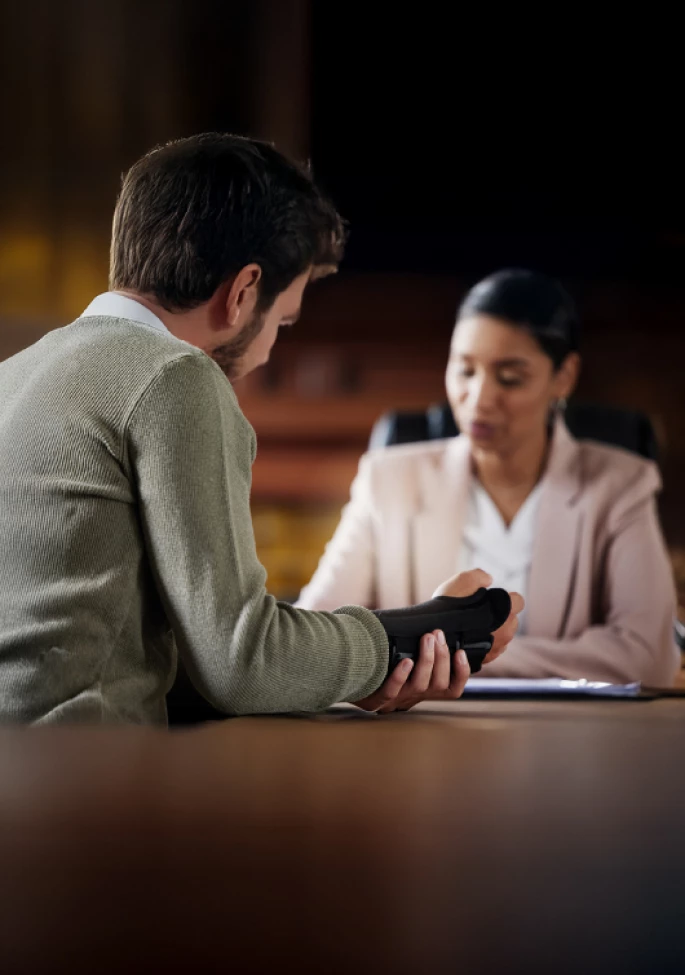In 1929, Belgian surrealist artist René Magritte took a canvas, painted a pipe on it, and wrote below, in French, “This is not a pipe.” The painting is called “The Treachery of Images,” and the point, to the extent surrealism is meant to have a point, is that the image of a thing is not the same as the thing itself. In a subtle way, an image always betrays.
Trials are a search for truth. But they are also retrospective enterprises, and in this way, they also betray. People make choices in real time without knowing how those choices will work out. Jurors, on the other hand, assess choices with full knowledge of their consequences, lending an air of inevitability to outcomes that were often anything but inevitable. In other words, jurors assess evidence using hindsight, and hindsight—as we all know—is 20/20.
There are well-studied tools available to lawyers that help address hindsight bias in jurors, however. Chief among these are “counterfactuals,” which are not the facts themselves but a kind of negative space around those facts that consists of “what could have been.” In our own lives, we often consider counterfactuals: how things could have been much worse or better had events unfolded differently. Counterfactual thinking is a process so crucial to human learning, in fact, that some computer scientists are looking to integrate it into artificial intelligence as a means to make AI more adaptive and better at weighing decisions and their consequences. Thankfully, human jurors come preprogrammed to receive and process counterfactuals at trial.
To be clear, counterfactuals can raise issues under the rules of evidence and are perhaps best used in closing arguments or with qualified experts where the facts support their use. But lawyers savvy enough to build counterfactuals into their cases from the beginning—and get them in front of the jury—do more than plead their case; they help jurors make wiser and more measured decisions, despite the perils of hindsight.
What Is a Counterfactual?
Faced with negative outcomes, most people seek to understand how such outcomes can be prevented in the future. Counterfactual statements support this desire by posing an alternative to reality, inviting an audience to compare what was with what might have been. They can emerge organically in jurors’ minds or be put forth by plaintiff or defense attorneys. Either way, counterfactuals can mitigate or strengthen hindsight bias by encouraging jurors to imagine whether different choices and actions would have led to a different outcome.
Thus, while counterfactuals are but one of a number of methods to reduce jurors’ hindsight bias, they also offer attorneys a unique avenue to increase jurors’ hindsight advantageously as it concerns a plaintiff’s, defendant’s, or third party’s role in an incident.
Three Types of Counterfactuals
Counterfactuals can be housed in three categories: upward, neutral, and downward. Upward counterfactuals explore how a situation could have turned out far better than it did, a style of thinking that generally makes people want to right the perceived wrong. Neutral counterfactuals suggest that—even if things had played out differently—the result would have been the same. Lastly, downward counterfactuals explore how things could have been far worse; when confronted with downward counterfactuals, people tend to feel better about the real outcome. At trial, each type of counterfactual plays a role in maximizing, neutralizing, or reversing hindsight bias.
1. The Upward Counterfactual: “If Only”
Example: “If only the city had fixed the road, the accident would not have happened.”
In this hypothetical example, the presenting attorney suggests that changing the city’s behavior would have prevented the bad outcome. The attorney thereby frames the city’s actual behavior as a direct cause of the bad outcome.
“If only” counterfactuals are frequently used by plaintiff attorneys to reinforce hindsight bias in jurors’ minds. This counterfactual glosses over the consideration of whether the city acted reasonably at the time, in the interest of encouraging jurors to jump right to causation. By focusing them on a single factor that (purportedly) could have prevented the outcome, the outcome appears more obvious. “That road was an accident waiting to happen,” jurors might say—so why did the city not see it and prevent it? In a personal injury lawsuit, this would likely translate into a greater allocation of blame and higher damages against the defendant.
The upward counterfactual is a powerful tool in a plaintiff lawyer’s toolbox. However, the defense can use its own “if only” statements to shift jurors’ scrutiny onto the plaintiff’s or a third party’s actions, inactions, and responsibilities: “If only the plaintiff was paying attention while driving, the accident would have been avoided.”
2. The Neutral Counterfactual: “Even If”
Example: “Even if the city had fixed the road, the accident still would have happened.”
Here, the attorney argues that the outcome was going to occur regardless of the party’s behavior. This counterfactual posits an alternative reality wherein the city did fix the road, but other factors—perhaps driver distraction, weather conditions, or alcohol—caused the accident anyway.
This type of counterfactual undoes the tendency to rely on hindsight by distancing the subject from the outcome. Defense attorneys can use it to focus jurors on alternative factors and make the actual outcome seem less obvious or less controllable. Of course, plaintiff attorneys can do the same to try to shift the focus away from their own client’s behavior.
3. The Downward Counterfactual: “Thank Goodness”
Example: “Thank goodness the city took all the precautions it did, or the loss would have been far, far worse.”
Now, the attorney gives the city credit for the many steps it did take to minimize risk. This downward counterfactual explores the benefits of the city’s decision-making, and implicitly asks the jury to weigh those benefits when considering the harm.
Downward counterfactuals tend to make people feel better about the outcome that occurred. In conjunction with hindsight bias, such counterfactuals acknowledge our fear of loss and transform it into relief regarding the current set of circumstances. Used wisely, such counterfactuals can engage jurors’ hindsight to benefit the defense.
Making the Most of Counterfactuals
Before using counterfactuals at trial, however, attorneys should keep several principles in mind.
Make Them Relevant and Believable
For jurors to be receptive to counterfactuals, they must be able to clearly visualize how the presented differences would (or would not) result in a different outcome. The easier it is for them to imagine, and the more it can be supported by logic and evidence, the more influential the counterfactual will be.
“If only the plaintiff took a different route that night, this would not have happened,” a defense attorney might posit. But that counterfactual, true as it may be, strays too far from the actual events and removes the plaintiff’s responsibility from the equation (no one would blame him for taking one route over another). Counsel would do well instead to focus on options that are controllable and readily available: “If only the plaintiff had not been speeding as he entered the work zone, he would have had more command of his vehicle and could have avoided or straddled the defect in the road.” In conjuring this plausible alternate reality, a counterfactual becomes more powerful than simply stating that the plaintiff’s recklessness caused the accident.
Build an Advantageous Timeline
Jurors often give extra weight to an event or events that appeared to “get the ball rolling.” Thus, in cases with a chain of causal events, attorneys would do best to construct their timeline to put opposing parties’ controllable and consequential actions near the beginning. Their client’s subsequent actions then are more easily seen as having a limited impact or as being a justified response to another party’s actions.
In our hypothetical case of the damaged road, for example, it matters where counsel starts the story. Plaintiff’s counsel might take jurors back to the city’s repeated decisions to overlook routine maintenance until the road became unsafe: “If only the city hadn’t ignored basic upkeep, kicked the can down the road for months, the road would never have been in such a dangerous condition.” Defense counsel, on the other hand, might begin with the evening of the fateful accident itself, shifting focus to the plaintiff’s state of mind and actions that facilitated the chain of events: “If only the plaintiff had listened to his friends and waited to sober up before hopping in his vehicle and leaving that bar, he would have had more control over his vehicle and his speed as he approached the work zone. He would have been able to heed the bright yellow caution signs and react appropriately to the road conditions, and this accident would never have occurred.”
Do Not Neglect Voir Dire
Some jurors are more or less likely to accept various counterfactuals. As such, voir dire—supplemented, if possible, by juror questionnaires and internet searches—will be a critical opportunity for counsel to determine who will be best for their case. What are the prospective jurors’ relevant experiences? Do they value taking personal responsibility for outcomes, or do they tend to blame external factors? What actions do they consider normal versus abnormal?
If assessing a potential jury, this might include searching for internet posts, memes, or retweets that help identify where a juror places responsibility. If they tend to blame external forces for an outcome—an “external locus of control,” in psychology terms—that person would likely tend toward the plaintiff’s theory of the case, that the defendant’s actions caused the plaintiff’s injuries. (One meme we have seen indicating such a mindset reads, “Before you start to judge me, step into my shoes and walk the life I’m living, and if you get as far as I am, just maybe you will see how strong I really am.”) The opposite is true of “internal locus of control” jurors, who favor personal responsibility and would likely relate more to defense arguments that the plaintiff made their own bed by acting irresponsibly. (Keep a lookout for sentiments such as, “Don’t complain about the snow on your neighbor’s roof when your own doorstep is unclean.”)
Final Thoughts
Trial lawyers are storytellers. But in telling those stories, lawyers should not get so caught up in establishing the facts that happened that they lose sight of the facts that did not. Jurors are already building narratives in that negative space, the home of hindsight and counterfactuals. By meeting them where they are, lawyers can work to control the narrative in a way that supports their clients; they can help jurors put themselves in the shoes of decision makers as they were making those decisions.
If hindsight can deceive, then reminding jurors “what could have been” can give them a better perspective on the truth. Sometimes, of course, a fact is a fact; an outcome is an outcome. But as another renowned artist, Taylor Swift, once sang, “You know the greatest films of all time were never made.”
References
[i] Sharp Penya, Lynette. (1998). “Counterfactuals and Juror Decision-Making: How the Alternatives Jurors Entertain Affect Their Judgments in Sexual Harassment Cases.” National Institute on Sexual Harassment, American Bar Association: F-10.
[ii] Stallard (aka Pitera), M.J. & Worthington, D.L. (1998). “Reducing the Hindsight Bias Utilizing Attorney Closing Arguments.” Journal of Law and Human Behavior, vol. 22(6), p. 671-683.
[iii] Sharp Penya, F-14.
This article was originally published in Law360. Republished with permission.








